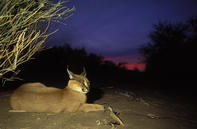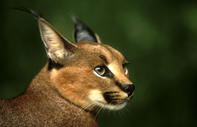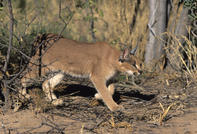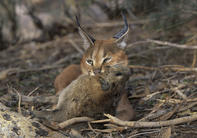Night Hunters
Caracal prefer to hunt by night which affords them the best cover but a degree of kills do take place during the day on cool or cloudy days.

The give-away black ears are tucked back when the cat stalks presenting only the sandy fur along the leading edge in the direction of the victim. It’s imperative that a caracal is not detected prematurely as its success depends on an unexpected pounce or a blinding dash over the last few metres.
The killing blow takes the form of a bite to the neck or throat. Birds are consumed entirely bar a few feathers. Other carcasses are eaten from the rump without the innards removed. Clumps of fur are plucked around the feeding site and the meat is neatly sheared away from the skin.
Jump and Climb

Caracal are superb jumpers and can jump 4 - 5 metres into the air from sitting. This is possible due to the power of huge hindquarters. The characteristic short stubby tail steadies them during these acrobatic leaps.
Large paws house heavily built, protractible claws that make no sound as the caracal moves. The dew claws are nifty devices too.
Higher up the wrist and not imprinting in the spoor, these are used as securing apparatus especially useful for climbing trees, when pulling down prey or even for use on an opponent when posturing proves inadequate. Caracal respond to danger by making a speedy dash into hiding without a backward glance.
Leopard Like

Caracals are excellent climbers and like leopards, they use trees to cache prey or to ambush sleeping birds of prey like Tawny eagles. They also use their climbing and leaping ability very successfully when pursuing a favourite rock-dwelling food source, dassies. Caracals are formidable predators.
They can take down prey the same size as leopards including female kudu, adult springbok and grey rhebok – species twice their own weight.
Farmers Foe or Helper?

Caracals are notorious stock thieves and cause farmers a great deal of financial loss annually.
However, these cats also offer farmers a service in pest control. Rodents are a favourite food-type, to which the caracal’s ability to launch from sturdy hindquarters up and upon prey is well suited.
Dassies are another favourite and are easily snapped up off rocky outcrops thanks to the caracal’s adept climbing and jumping skills.
Even jackal pups make for an occasional meal. Caracals do more than benefit farmers by their choice of prey species; they play a pivotal role in keeping ecosystems balanced and other wildlife populations in check.
By Megan Emmett